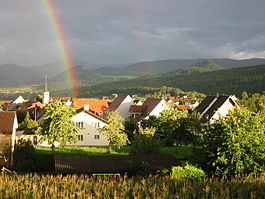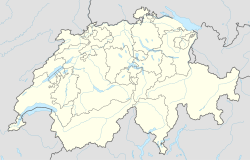Röschenz
| Röschenz | ||
|---|---|---|
 |
||
|
||
| Coordinates: 47°25′N 7°29′E / 47.417°N 7.483°ECoordinates: 47°25′N 7°29′E / 47.417°N 7.483°E | ||
| Country | Switzerland | |
| Canton | Basel-Landschaft | |
| District | Laufen | |
| Area | ||
| • Total | 10.07 km2 (3.89 sq mi) | |
| Elevation | 450 m (1,480 ft) | |
| Population (Mar 2016) | ||
| • Total | 1,859 | |
| • Density | 180/km2 (480/sq mi) | |
| Postal code | 4244 | |
| SFOS number | 2791 | |
| Surrounded by | Burg im Leimental, Dittingen, Kleinlützel (SO), Laufen, Liesberg, Metzerlen-Mariastein (SO) | |
| Website |
www SFSO statistics |
|
Röschenz is a municipality in the district of Laufen in the canton of Basel-Country in Switzerland.
Röschenz is first mentioned in 1290 as de Roetschentzo. Until 1723 it was known as Reuschansse.
Röschenz has an area, as of 2009[update], of 10.07 square kilometers (3.89 sq mi). Of this area, 3.26 km2 (1.26 sq mi) or 32.4% is used for agricultural purposes, while 6.04 km2 (2.33 sq mi) or 60.0% is forested. Of the rest of the land, 0.72 km2 (0.28 sq mi) or 7.1% is settled (buildings or roads), 0.02 km2 (4.9 acres) or 0.2% is either rivers or lakes and 0.02 km2 (4.9 acres) or 0.2% is unproductive land.
Of the built up area, housing and buildings made up 4.5% and transportation infrastructure made up 2.0%. Out of the forested land, 58.8% of the total land area is heavily forested and 1.2% is covered with orchards or small clusters of trees. Of the agricultural land, 18.7% is used for growing crops and 12.8% is pastures. All the water in the municipality is flowing water.
The municipality is located in the Laufen district, in the Lützel valley on a terrasse in the Blauen hills. It consists of the linear village of Röschenz.
The blazon of the municipal coat of arms is Per pale, Sable a Crozier Argent, Argent between two Roses Gules, centered Or and lapped Vert a Bar wavy Azure.
Röschenz has a population (as of March 2016[update]) of 1,859. As of 2008[update], 7.2% of the population are resident foreign nationals. Over the last 10 years (1997–2007) the population has changed at a rate of 15.6%.
Most of the population (as of 2000[update]) speaks German (1,526 or 94.9%), with French being second most common (17 or 1.1%) and Italian language being third (14 or 0.9%).
...
Wikipedia




